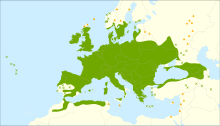
Back Sambucus nigra AN خمان أسود Arabic خمان اسود ARZ Sambucus nigra AST Qara gəndəlaş Azerbaijani Мәрәүәр ағасы Bashkir Бузіна чорная Byelorussian Черен бъз Bulgarian Zova BS Saüc Catalan
| Sambucus nigra | |
|---|---|

| |
| Shrub in flower | |
| Scientific classification | |
| Kingdom: | Plantae |
| Clade: | Tracheophytes |
| Clade: | Angiosperms |
| Clade: | Eudicots |
| Clade: | Asterids |
| Order: | Dipsacales |
| Family: | Adoxaceae |
| Genus: | Sambucus |
| Species: | S. nigra
|
| Binomial name | |
| Sambucus nigra | |

| |
| Distribution in Europe | |

| |
| Natural range of North American subspecies: S. cerulea (dark/light blue) and S. canadensis (green/red) | |
Sambucus nigra is a species complex of flowering plants in the family Adoxaceae native to most of Europe.[1] Common names include elder, elderberry, black elder, European elder, European elderberry, and European black elderberry.[2][3] It grows in a variety of conditions including both wet and dry fertile soils, primarily in sunny locations. The plant is widely grown as an ornamental shrub or small tree. Both the flowers and the berries have a long tradition of culinary use, primarily for cordial and wine.[4]
Although elderberry is commonly used in dietary supplements and traditional medicine, there is no scientific evidence that it provides any benefit for maintaining health or treating diseases.[5]
- ^ "Flora Europaea Search Results". Rbg-web2.rbge.org.uk. Retrieved 13 October 2017.
- ^ "Sambucus nigra". Integrated Taxonomic Information System.
- ^ "Plants profile for Sambucus nigra L. (black elderberry)". Natural Resources Conservation Service, US Department of Agriculture. 2023. Retrieved 13 June 2023.
- ^ Cite error: The named reference
RHSAZwas invoked but never defined (see the help page). - ^ "European elder". National Center for Complementary and Integrative Health, US National Library of Medicine. 1 August 2020. Retrieved 4 September 2021.